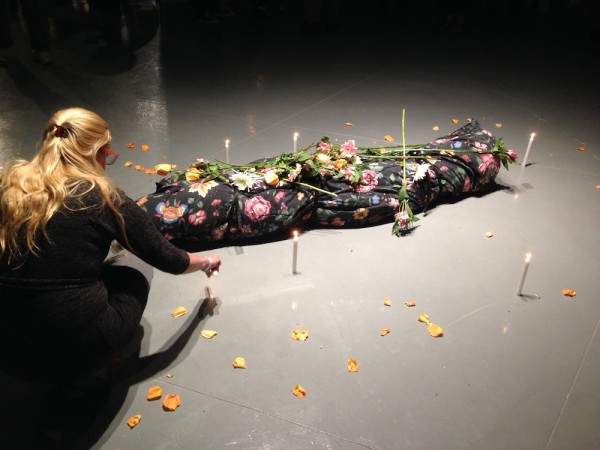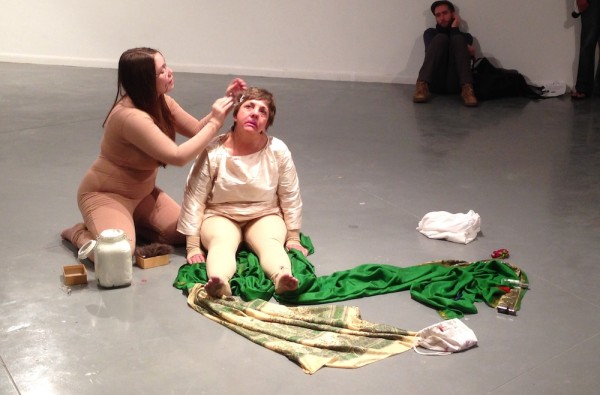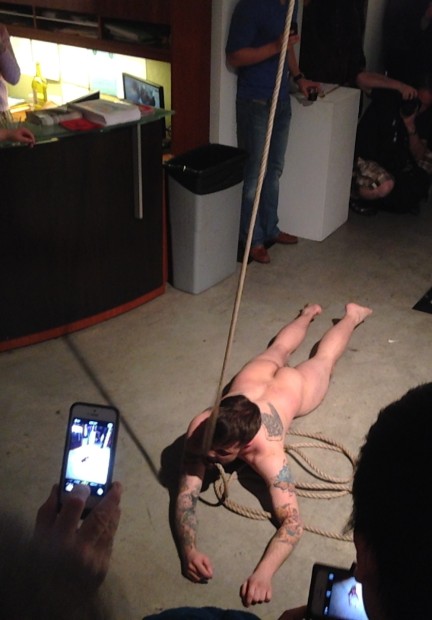The second night of the 2014 Lone Star Performance Explosion was chaotic. Performances staged in the Art League Houston’s two galleries and two classrooms overlapped. Without an MC, or a reliable timetable (the printed lineup quickly lost all relation to what was happening in the gallery), it was difficult to know who was performing where. Attendees rushed en masse from one space to another as rumor passed that something was happening or was about to happen; performers made abortive starts, only to have their audience desert suddenly to witness something else. These are just the parts I saw. I didn’t see it all, and this was but one of three evenings of events!

It began with a ritualistic wake by Houston veteran Elia Arce. A limp figure bundled in a black brocade duvet was carried into the Art League’s main gallery on the shoulders of three pallbearers. Laid in the center of the floor, the bundle was strewn with cut flowers and surrounded by votive candles distributed to spectators by helpers, as the PA system boomed a fuzzy recording of a telephone conversation between a tearful woman and a calming, professional-voiced mediator. Echoes in the concrete gallery defeated attempts to catch more than snippets of the dialog: was it a suicide hotline, or a 911 operator? But the sense of emotional crisis was loud and clear. The prone figure was the anonymous, venerated victim, an appropriate beginning for a night largely concerned with evoking, celebrating, and perpetrating victimization in various forms.

Courtney Brown and Alison Starr, as Performance SW, mimed a theatrical duet on female roles. Similarly sized and shaped women in fleshtone catsuits, one young, one older, they acted out symmetrical parts: the younger woman was the active figure, gently ushering, prodding and finally dragging the limp, passive older woman through her performance, as if she were caregiver to a docile, slightly petulant invalid. The most poignant moment in the piece was when the younger woman, looking into the older woman’s face as if into a mirror, applied eyeliner to her own face in imitation of wrinkles. Much of the piece was a grotesque parody of primping: the younger woman smeared the elder with lipstick, adhered wads of hair to her neck with lardlike goop, and stuffed her into a stiff white dress like a wedding gown and then dragged her offstage by its hem, like a sack of potatoes.

Daniel Bertalot‘s Earworm annoyed even this tolerant crowd. Though willing to submit to blindfolded communal dancing, or to having mild electrical shocks run through their temples, the earsplitting feedback caused by Bertalot’s belly pressing against a microphone set at waist height succeeded in driving people out of the gallery and into the courtyard.
J. Morrison‘s Escape from Houston offered a control experience, like an initiation ritual into a mild-mannered fraternity. Entering through a child’s play-tunnel, three participants at a time were asked to surrender themselves to progressively more invasive demands by a decorous maitre d’ in a leather bondage mask. Instructed via printed signs and formal gestures, we first removed our shoes and socks, (OK, I did that at the airport last weekend) then relinquished our cell phones, wallets and keys (hmm . . . safe enough, no one around to steal them), and were rewarded with a shot of bourbon (or Perrier), and a mini-striptease stage show. That level of trust established, we allowed the ringmaster to buckle us into masks of our own and lead us out into a courtyard, where we were blindfolded. (Uncomfortable yet?) We joined hands in a tight circle to sway slowly to trancey music.
The catharsis came at the end. Released from our blindfolds, we were ushered into a room where a ring of ridiculous inflatable dinosaurs prayed to a lighted disco ball. Each of us seized one of the oversized toys and expelled the tensions built up by the piece by romping them with a wholehearted joy that would have been impossible twenty minutes earlier. Silly? Yes. Transformative? Yes. I didn’t feel as though I’d escaped, but the piece was an interesting demonstration of the elastic nature of willingness.
Abel Azcona’s Utero was far and away the most powerful piece I saw (I missed the reportedy tense ice-chest immersion piece while I was romping the dinosaurs), but parts of it should not have happened. In the beginning of the piece, Azcona entered, nude, and began struggling with the coils of a thirty-foot length of coarse rope tied to an overhead beam. After writhing, biting, sucking and twisting with fury and abandon, Azcona tied the rope around his neck and ran through the crowd, to be jerked backwards with a horrible gargling cry, like a mad dog at the end of a short chain.
This is too dangerous. I appreciate that its danger was its power. I appreciate that Azcona was using this technique to force his audience into his piece, confronting each of us with an unwitnessable act, compelling us to intervene, or leave. I appreciate that it worked. But it’s still too dangerous.

There are many contexts in which young people, particularly young men, express themselves through personal endangerment: from suicide bombing to skateboarding. Where do you draw the line? Unlike many endurance actions, in which the level of danger builds slowly, allowing plenty of time for intervention, the potential of this particular action to turn suddenly, unintendedly fatal was too great. Before the crowd knew what Azcona was about to do, he could have been seriously hurt. If this was the WWF, or conventional theater, I’d assume the performer knew the risks, but in the joyfully amateur, improvisational world of performance art this is not a given.
This time, he survived. After three harrowing runs, members of the crowd, feeling as I did, blocked his way, wrestling him to the ground and untying him, allowing him to crawl to a washtub of dirty water in the main gallery, where his wallowing, vomiting, and slithering came as a relief.

For a view of Night 3 of the Lone Star Explosion, held at notsuoH, read Robert Boyd’s post on The Great God Pan is Dead.



7 comments
Thank you Bill for the time to review our Second International Performance Art Biennale.
As the project manager for this and the 2012 event I would like to add a few comments.
In your first paragraph you wrote “Without an MC, or a reliable timetable”. I couldn’t agree with you more. When I found myself yelling at the audience to move this way or that or to see what was going on over here, I really regretted not having a more hands on approach with our young, but VERY TALENTED, creative directors. Though, I must add also that every mistake or confusion creates it’s own dynamic and if you had seen all the way to the end of Sunday afternoon, that dynamic was a learning growing powerful animal.
This event was not repeated by the same creative source as the first biennale, so few lessons learned the first time around were translated to this new group. Our plan is to work with new creatives each biennale, so I value your critique and will work to make a better scaffolding for them to work from.
Even with all the confusion there were some performances so strong that they will be talked about and used as a source of inspiration to a great many of this new generation performance artists. I especially liked Autumn Knights. I was everything I love in performance art. Simple, brilliant and beautiful.
Another thing you mentioned was the powerfulness of Abel Aconza’s work. I probably would have fainted away clean if I had not been doing J. Morrison’s piece at the time. “Too dangerous” indeed. And we had just learned the night before that an audience at a performance art event is more than willing to watch while the artist puts themselves in harms way, or even hand them the tequila. I did a lot of holding my breath and reminding myself that it is important that we let these YOUNG new generation of artists have a voice and a voice that is not stifled. That and I had the artists hold harmless contracts under my arm in a vice grip.
The panel at CAMH where Autumn Hays interviewed Erik Hokenson and Jill McDermid about their seven years of running Grace Exhibition Space in Brooklyn truly brought to light the need and complications of “breaking the rules”.
I’m wondering if you were there or if you saw any of the other workshops, panels, talks and performances that went on throughout the week.
It is an exciting time for performance art in Houston. A Renaissance of sorts. Any problems with programing or perception are not strong enough to have spoiled the incredible energy floating around Houston the past few days.
For the second time, a small group of artists trying there best to be organizers, sacrificed everything, even well into their personal lives, to bring to Houston, world renowned artists from China, Korea, Argentina, Estonia, Finland, Costa Rica, Mexico, Spain, France and more. Almost every dollar raised for their meals, their transportation and their entertainment was provided generously by the blood sweat and tears of the organizers, Houston Art Alliance and a small group of sponsors.
Any criticism of this event should not overshadow the fact that a powerful movement is on the rise and that thanks to a few dedicated local artists, Houston won’t be left behind.
Utero- I talked to the artist about his piece. He gave be some background. When he was born the umbilical cord had wrapped around his neck and literally and figuratively his life began in strangulation . His mother was a heroine addict and prostitute in Madrid which informed all three of his pieces during the festival. I asked if it bothered him that the audience stopped his third attempt in which seemed like a suicide attempt. He said he uses a special kind of material for the rope and a type of knot that minimizes the risk and had no thought of dying. He said his worse injury was when someone cut the rope and he broke his nose running into a wall. And no he expects to be stopped (9 tries is the most the audience has ever allowed.
I thought about Stanley Milgram’s psychological experiments about power and control and how far would we go or allow him to go before we said no more this is wrong and we won’t be a part. I was looking for a knife and angry at his putting my humanity to some sort of test for art-how the night would have gone if he had died. I left after his performance- rather unsettled and upset.
I heard someone in a conversation say this… “Sometimes I don’t like art that’s good for you, or teach us that invaluable lesson about humanity and ourselves. I have a kind of disdain for a certain kind of prestige art… Something that’s supposed to be about suffering and victimization and how we can all be better people. I just don’t really respond to earnest art teaching us something anymore… It more often than not feels condescending.
“heroine addict!” Good one. Now he’s 2nd generation addict — addicted to heros and heroines intervening to prevent his (performed) self-destruction.
This is what gives Contemporary art a bad name. But it’s indicative of our times, where people think they can BE something without doing their homework. Really good performance art is transformative, but in the wrong hands, it’s just confrontational. Anyone can shock, take their clothes off, sell tricks for $15, or sing a bad version of the National Anthem. The 60s let the Genie out of the bottle, but you have to be careful what you ask for…
I don’t understand… people go to a festival of Avant Garde performance pieces and are uncomfortable when the performance makes them uncomfortable?
You can participate in the performance like people seemed to in this case, or observe. I would not expect a performer to abide by my moral rules, nor would I be shocked if he did hurt himself. There are many forms of entertainment – including American Football – where there are real injuries to performers and no one tries to stop them. So in this case – unless you wanted to be a part of the performance – I don’t see how seeing someone do something they had volunteered and prepared for would make you both stay to watch, and not feel comfortable about. Would a self flagellation performance piece that drew blood make you want to intervene as well?
It’s not the risk, so much as the possibility that the performer does not understand the risk or doesn’t care, that compels intervention. In football, the risks are traditional, well known, and mostly obvious. Efforts are made to minimize them. The players are not trying to get hurt, and no one is happy when they do. It’s interesting that you use it as an example- when the extent and prevalence of head trauma in football players became known, people did start to intervene.